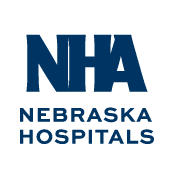NHA HQIC Creating a Culture of Patient Safety Virtual Learning Cohort
NHA HQIC Creating a Culture of Patient Safety
Virtual Learning Cohort in Partnership with Nebraska Coalition of Patient Safety
Learning Sessions and Rapid Cycle Improvement Project
Program Overview:
This 6-part learning cohort will be led by the team at the Nebraska Coalition of Patient Safety – Emily Barr and
Carla Snyder will focus on creating a culture of patient safety. Specifically, the sessions will discuss Just Culture,
reporting structure, partnership with your PSO, TeamSTEPPS tools, and the importance of patient safety in quality
of care. Upon completion of this cohort, teams will be able to understand the importance of having a strong
culture of patient safety, what tools and processes support that culture, and how this will allow your organization
to offer safe, high-quality care to your patients.
Speaker Bios:
Emily Barr, OTD, MBA, OTR/L, BCG, Executive Director of Nebraska Coalition of Patient Safety
Emily is a registered and licensed occupational therapist and holds a board certification in gerontology through
the American Occupational Therapy Association. She has clinical experience in various settings serving adult and
older adult clients and holds several certifications in dementia care programming. She also previously worked as
a full-time associate professor and program director at Nebraska Methodist College and has been with the
Nebraska Coalition for Patient Safety as its Executive Director since May 2022.
Carla Snyder, MHA, MT(ASCP)SBB, CPHQ, Patient Safety Program Director of Nebraska
Coalition of Patient Safety
Carla’s clinical background is in laboratory medicine, and she has a master’s in healthcare administration degree.
She has worked in a variety of clinical settings including Nebraska Medicine, OneWorld Community Health
Centers, Memorial Community Hospital in Blair, NE, and Community Blood Bank in Lincoln, NE. She has held a
variety of roles in these various settings: bench tech, department manager, Operations Director, and Patient
Safety Clinical Quality Manager. In all these settings she has been involved in patient care and quality
improvement initiatives. She is a TeamSTEPPS Master Trainer, a Six-Sigma Green Belt, a Zero Harm Trainer, and a
Certified Professional in Healthcare Quality.
Target Audience:
Multidisciplinary Team; Frontline Staff, Organizational Leaders, Risk Managers, Safety Officers
Cost:
No cost is associated with this program for HQIC enrolled hospitals
SESSION #1: October 4th 12:00-1:30 PM
Topic: Importance of Total Systems Safety, Just Culture Basics, Workforce Safety
Learning Objectives:
At the completion of the session, participants will be able to:
• Explain the concept of Total Systems Safety and how it applies to establishing an organization’s culture of
safety.
• Define the characteristics of a Just Culture.
• Categorize individuals’ actions in events of harm as human error, at-risk, or reckless behavior.
• Summarize the impact of workforce safety (both psychological and physical) to patient safety.
Pre-work: Review Just Culture algorithm per copyright allowance.
Session #2: October 18th 12:00-1:00 PM
Topic: Tools for Investigating Events of Harm (utilizing a mock Reporting Committee; demonstrate Cause
Mapping & Root Cause Analysis)
Learning Objectives:
At the completion of the session, participants will be able to:
• Describe the steps in performing and facilitating an RCA.
• Develop a basic Cause Map of an event.
• Explain the importance of a Cause Map within an RCA.
Pre-work: Review Cause Mapping Resource; Begin a mini-RCA or Cause Map of a provided event.
Session #3: November 1st 12:00-1:00 PM
Topic: Patient safety for care transitions and integrating patient and family engagement
Learning Objectives.
By the end of the session, participants will be able to:
• Understand the importance of safe and seamless care transitions to decrease risk of re-hospitalization,
post-discharge complications, and/or mortality.
• Evaluate the seven elements essential for safe and seamless transitions as outlined by the National
Transitions of Care Coalition (NTCC).
• Utilize tools to integrate patients, family members, and others into the client’s plan of care and for
transition readiness.
• Compare facilitators and barriers within your own organization related to care transitions and design
ideas for future intervention.
Pre-work: Review NTCC document sent out via email.
Session #4: November 15th 12:00-1:00 PM
Topic: TeamSTEPPS basics and integrating Surveys on Patient Safety Culture into the work setting
Learning Objectives:
By the end of the session, participants will be able to:
• Identify the foundational tenets of the TeamSTEPPS curriculum targeted towards patient safety.
• Explain how TeamSTEPPS can enhance communication and teamwork among healthcare professionals.
• Describe AHRQ’s Surveys on Patient Safety Culture® (SOPS) and how they are used within organizations.
• Evaluate a case study on a SOPS survey to determine areas of improvement related to quality, safety,
effectiveness, and efficiency.
Pre-work: Download TeamSTEPPS app on your smartphone and explore features.
Session #5: November 29th 12:00-1:00 PM
Topic: Quality improvement processes and tools to address patient safety
Learning Objectives:
By the end of the session, participants will be able to:
• Describe strategies to adopt evidence-based practices into quality improvement efforts.
• Examine common quality improvement tools and effectiveness to address patient safety.
• Critically appraise a quality improvement effort within your organization using the implementation and
improvement guiding questions, to address factors that may impede outcomes.
• Critically appraise a quality improvement effort within your organization using the implementation and
improvement guiding questions to address factors that may impede outcomes (Hierarchy of
Interventions). Compare Just Culture and High Reliability Organization concepts for risk reduction and
safety event analysis(Review the Threshold of Investigation).
Pre-work: Review sample action plan.
Session #6: December 14th 12:00-1:00 PM
Topic: PSO Reporting Framework (value of PSO membership, Safe Tables)
Learning Objectives:
At the completion of the session, participants will be able to:
• Describe the legal confidentiality protections provided to members of a PSO.
• Identify the steps a member needs to complete to establish their Patient Safety Evaluation System.
• Define a Safe Table and explain its value.
• Explain the responsibilities of the PSO when hosting a Safe Table.
• Explain the responsibilities of the attendees of a Safe Table.
Pre-work: None

